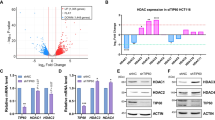Abstract
Although disruption of histone modification patterns is a common hallmark of human cancer, our knowledge of the mechanistic role of histone-modifying enzymes in its generation is very limited. We have recently identified an inactivating mutation in the histone deacetylase-2 (HDAC2) in sporadic carcinomas with microsatellite instability and in tumors arising in individuals with hereditary nonpolyposis colorectal cancer syndrome. Since HDAC2 seems to be a central player in epigenetic gene repression, we wondered whether HDAC2-truncating mutations conferred a particular expression signature on these cancer cells. Using unsupervised clustering analysis in microsatellite-unstable colorectal cancer cell lines, we have found that HDAC2 mutant cells (RKO and Co115) show a characteristically different expression microarray signature from HDAC2 wild-type cells (HCT-116, SW48, HCT-15 and LoVo). HDAC2 mutant cells exhibit upregulation of tumor-promoting genes, such as those of tyrosine kinases, mediators of cell cycle progression and angiogenic factors. The overexpression of these genes is associated with a loss of HDAC2 recruitment and a gain of histone H4 hyperacetylation in their particular 5′-end promoters, as observed by chromatin immunoprecipitation. Transfection of wild-type HDAC2 in mutant cells reverted this epigenetic pattern by repressing the transforming genes in association with HDAC2 promoter occupancy. These results suggest a role for HDAC2 mutations in human tumorigenesis through the derepression of key genes from multiple cellular transformation pathways.



Similar content being viewed by others
Accession codes
Accessions
GenBank/EMBL/DDBJ
References
Ballestar E, Paz MF, Valle L, Wei S, Fraga MF, Espada J et al. (2003). Methyl-CpG binding proteins identify novel sites of epigenetic inactivation in human cancer. EMBO J 22: 6335–6345.
Dopazo J, Carazo JM . (1997). Phylogenetic reconstruction using an unsupervised growing neural network that adopts the topology of a phylogenetic tree. J Mol Evol 44: 226–233.
Esteller M . (2007). Cancer epigenomics: DNA methylomes and histone-modification maps. Nat Rev Genet 8: 286–298.
Fahrner JA, Eguchi S, Herman JG, Baylin SB . (2002). Dependence of histone modifications and gene expression on DNA hypermethylation in cancer. Cancer Res 62: 7213–7218.
Fraga MF, Ballestar E, Villar-Garea A, Boix-Chornet M, Espada J, Schotta G et al. (2005). Loss of acetylation at Lys16 and trimethylation at Lys20 of histone H4 is a common hallmark of human cancer. Nat Genet 37: 391–400.
Frolov MV, Dyson NJ . (2004). Molecular mechanisms of E2F-dependent activation and pRB-mediated repression. J Cell Sci 117: 2173–2181.
Glozak MA, Seto E . (2007). Histone deacetylases and cancer. Oncogene 26: 5420–5432.
Jones PA, Baylin SB . (2007). The epigenomics of cancer. Cell 128: 683–692.
Kouzarides T . (2007). Chromatin modifications and their function. Cell 128: 693–705.
Montgomery RL, Davis CA, Potthoff MJ, Haberland M, Fielitz J, Qi X et al. (2007). Histone deacetylases 1 and 2 redundantly regulate cardiac morphogenesis, growth, and contractility. Genes Dev 21: 1790–1802.
Nguyen CT, Gonzales FA, Jones PA . (2001). Altered chromatin structure associated with methylation-induced gene silencing in cancer cells: correlation of accessibility, methylation, MeCP2 binding and acetylation. Nucleic Acids Res 29: 4598–4606.
Richon VM, Sandhoff TW, Rifkind RA, Marks PA . (2000). Histone deacetylase inhibitor selectively induces p21WAF1 expression and gene-associated histone acetylation. Proc Natl Acad Sci USA 97: 10014–10019.
Ropero S, Esteller M . (2007). The role of histone deacetylases (HDACs) in human cancer. Mol Oncol 1: 19–25.
Ropero S, Fraga MF, Ballestar E, Hamelin R, Yamamoto H, Boix-Chornet M et al. (2006). A truncating mutation of HDAC2 in human cancers confers resistance to histone deacetylase inhibition. Nat Genet 38: 566–569.
Seligson DB, Horvath S, Shi T, Yu H, Tze S, Grunstein M et al. (2005). Global histone modification patterns predict risk of prostate cancer recurrence. Nature 435: 1262–1266.
Strahl BD, Allis CD . (2000). The language of covalent histone modifications. Nature 403: 41–45.
Trivedi CM, Luo Y, Yin Z, Zhang M, Zhu W, Wang T et al. (2007). Hdac2 regulates the cardiac hypertrophic response by modulating Gsk3 beta activity. Nat Med 13: 324–331.
Zhu P, Martin E, Mengwasser J, Schlag P, Janssen KP, Göttlicher M . (2004). Induction of HDAC2 expression upon loss of APC in colorectal tumorigenesis. Cancer Cell 5: 455–463.
Acknowledgements
The work was supported by the Health (FIS01-04) and Education and Science (I+D+I MCYT08-03, FU2004-02073/BMC and Consolider MEC09-05) Departments of the Spanish Government, the European Grant Transfog LSHC-CT-2004-503438 and the Spanish Association Against Cancer (AECC). SR is a ‘RamÓn y Cajal’ Researcher.
Author information
Authors and Affiliations
Corresponding author
Additional information
Supplementary Information accompanies the paper on the Oncogene website (http://www.nature.com/onc)
Rights and permissions
About this article
Cite this article
Ropero, S., Ballestar, E., Alaminos, M. et al. Transforming pathways unleashed by a HDAC2 mutation in human cancer. Oncogene 27, 4008–4012 (2008). https://doi.org/10.1038/onc.2008.31
Received:
Revised:
Accepted:
Published:
Issue Date:
DOI: https://doi.org/10.1038/onc.2008.31
- Springer Nature Limited
Keywords
This article is cited by
-
HDAC2 inhibits EMT-mediated cancer metastasis by downregulating the long noncoding RNA H19 in colorectal cancer
Journal of Experimental & Clinical Cancer Research (2020)
-
Driver mutations of cancer epigenomes
Protein & Cell (2014)
-
Expression and function of nuclear receptor co-activator 4: evidence of a potential role independent of co-activator activity
Cellular and Molecular Life Sciences (2012)
-
The histone deacetylase inhibitor valproic acid sensitizes human and canine osteosarcoma to doxorubicin
Cancer Chemotherapy and Pharmacology (2011)
-
Mismatch repair deficient colorectal cancer in the era of personalized treatment
Nature Reviews Clinical Oncology (2010)




